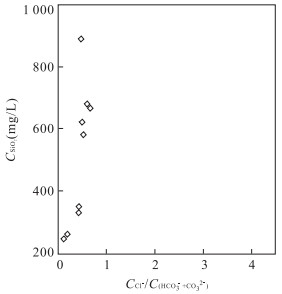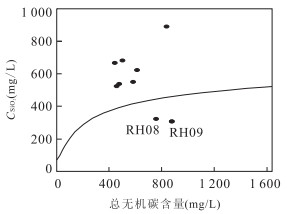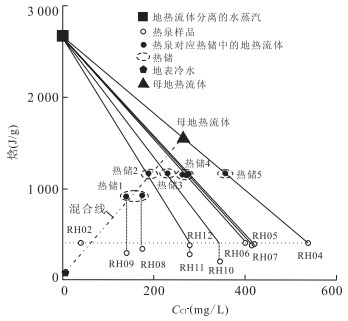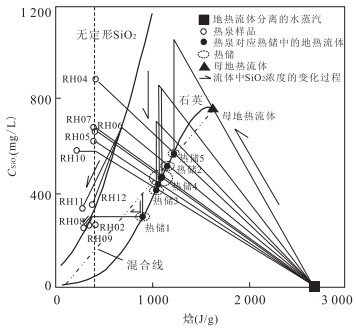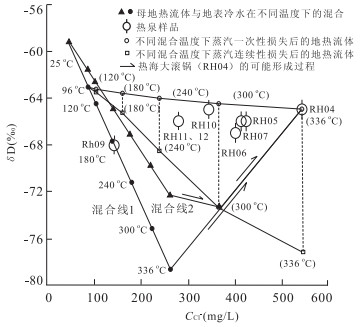Evaluation of Temperature of Parent Geothermal Fluid and Its Cooling Processes during Ascent to Surface: A Case Study in Rehai Geothermal Field, Tengchong
-
摘要: 高温地热系统中赋存着大量的地热能资源.为了进一步了解高温地热系统, 以腾冲热海热田为典型研究区, 利用热泉地球化学组成, 基于多种地球化学模型确定了热田深部母地热流体的温度, 并分析了其升流后经历的不同冷却过程.热海热田的硫磺塘水热区和热水塘水热区所排泄的热泉源自共同的深部热储, 该热储中母地热流体的Cl-质量浓度为265 mg/L, 温度为336 ℃.在热海热田, 母地热流体在经历绝热冷却过程后直接形成了泉口温度最高的大滚锅泉, 而其他中性泉均由母地热流体先与浅部地下冷水混合再经历绝热冷却形成.母地热流体的深部热储之上存在多个温度在200 ℃以上的热储, 这些热储的形成受控于热海地区发育的多组方向不同的断裂.Abstract: High temperature geothermal system contains plenty of geothermal resources. In order to further understand the high temperature geothermal system, taking the Rehai geothermal field of Tengchong as a typical study area and the geochemical compositions of Rehai hot springs as basic data, the temperature of parent geothermal fluid (PGF) below Rehai is estimated by use of multiple geochemical models, based on which the cooling processes of PGF during its ascent to surface are analyzed as well. The geothermal waters discharged from both Liuhuangtang and Reshuitang of Rehai originate from the same deep reservoir where a parent geothermal fluid with Cl- concentration of 265 mg/L and temperature of 336 ℃ was identified. The Dagunguo spring with the highest vent temperature at Rehai was formed via direct adiabatic cooling of PGF, whereas the other neutral springs are primarily the results of mixing between PGF and shallow cold groundwater, although boiling was also involved after the mixing. Above the deep reservoir containing PGF, there exist many geothermal reservoirs with temperatures higher than 200 ℃. The formation of these reservoirs is possibly controlled by the faults with different stretching directions at Rehai.
-
图 3 热海地热水中K+、Mg+和Ca2+质量浓度数值之间的相互关系
Fig. 3. The concentration relationship of K+、Mg+ and Ca2+ for Rehai geothermal waters
表 1 热泉样品的基本特征
Table 1. Major characteristics of geothermal water samples
编号 泉名 温度(℃) pH 电导率(μs/cm) 溶解氧(mg/L) 总无机碳(mg/L) 矿化度(mg/L) RH02 珍珠泉 96.0 6.42 653 0.03 7.6 528 RH04 大滚锅 96.6 7.98 5 290 2.45 834.2 2 940 RH05 怀胎井 92.0 8.26 4 290 0.78 612.0 2 147 RH06 鼓鸣泉 96.0 8.93 4 430 0.00 441.6 2 159 RH07 眼镜泉(姊妹泉) 94.0 8.85 4650 0.00 501.3 2 239 RH08 小滚锅 82.0 7.50 3 280 0.13 760.5 1 474 RH09 大滚锅2 70.0 8.20 3 790 0.63 876.7 1 606 RH10 无名 49.1 9.16 3 940 0.04 467.2 2 009 RH11 无名 65.8 6.89 2 811 0.18 586.9 1 510 RH12 无名 90.0 8.19 2 860 0.00 475.7 1 413 注:总无机碳以CO2形式计算;数据引自Guo and Wang(2012). 表 2 热泉样品主要化学组分的质量浓度
Table 2. Concentrations of major chemical constituents of geothermal water samples
编号 HCO3- CO32- SO42- Cl- Ca2+ Mg2+ Na+ K+ SiO2 B Li Rb Cs 电荷不平衡(%) RH02 5.5 0.0 128.2 39.2 2.3 0.40 67.7 15.9 262.0 2.01 500 246.7 46.2 -5.4 RH04 1 059.0 73.1 19.7 539.1 0.3 0.02 725.5 107.6 889.8 16.98 6 133 1 282.0 671.1 -1.1 RH05 768.4 70.3 17.1 419.6 0.3 0.03 521.2 75.7 621.7 12.44 4 289 1 000.0 515.6 -5.0 RH06 415.9 192.1 14.7 401.2 0.4 0.01 552.0 81.0 667.0 13.24 4 378 1 064.0 535.6 -1.9 RH07 499.8 190.5 15.3 413.6 0.3 0.01 574.5 83.9 678.7 14.13 4 667 1 124.0 564.4 -2.2 RH08 982.9 12.9 20.5 174.8 11.8 1.42 412.2 33.6 260.5 5.61 1 140 402.2 142.9 -5.5 RH09 1 147.0 55.0 15.7 140.4 2.7 0.49 506.7 38.7 247.3 6.63 1 382 444.4 165.1 -3.6 RH10 517.8 127.3 32.7 344.7 1.1 0.30 489.3 72.0 581.2 12.27 4 200 980.0 520.0 -2.2 RH11 665.4 1.1 52.1 279.5 2.4 0.08 334.2 51.9 330.0 7.93 2 778 668.9 340.0 -9.7 RH12 615.6 35.1 23.8 279.5 2.4 0.16 338.7 50.9 350.0 8.14 2 867 657.8 360.0 -9.4 注:Li、Rb、Cs的质量浓度单位为μg/L;其他组分单位为mg/L;电荷不平衡的计算:$100 \times \left[ {\left({\sum {Z{m_c} - |\sum {Z{m_a}} |} } \right)/\left({\sum {Z{m_c} + |\sum {Z{m_a}} |} } \right)} \right]$,其中Z为离子化合价,mc、ma分别为阳离子和阴离子摩尔浓度;引自Guo and Wang(2012). 表 3 热泉样品的氘值(RH02、RH08除外)
Table 3. δD values of hot spring samples (except for RH02 and RH08)
编号 RH04 RH05 RH06 RH07 RH09 RH10 RH11 RH12 硫磺塘冷水 δD(‰) -65.0 -66.0 -67.0 -66.0 -68.0 -65.0 -66.0 -66.0 -59.3 注:硫磺塘冷水氘值佟伟和章铭陶(1989). 表 4 Cl-与地热流体中特征组分(B、Li、Rb和Cs)的相关系数
Table 4. Correlation coefficients between Cl- and some other characteristic constituents in geothermal water (B, Li, Rb and Cs)
Cl--B Cl--Li Cl--Rb Cl--Cs 相关系数 0.954 6 0.970 0 0.957 3 0.963 5 -
Arnórsson, S., 1985. The Use of Mixing Models and Chemical Geothermometers for Estimating Underground Temperatures in Geothermal Systems. Journal of Volcanology and Geothermal Research, 23(3-4): 299-335. doi: 10.1016/0377-0273(85)90039-3 Arnórsson, S., Gunnlaugsson, E., Svavarsson, H., 1983. The Chemistry of Geothermal Waters in Iceland. Ⅱ. Mineral Equilibria and Independent Variables Controlling Water Compositions. Geochimica et Cosmochimica Acta, 47(3): 547-566. doi: 10.1016/0016-7037(83)90278-8 Bai, D.H., Liao, Z.J., Zhao, G.Z., et al., 1994. The Inference of Magmatic Heat Source beneath the Rehai (Hot Sea) Field of Tengchong from the Result of Magnetotelluric Sounding. Chinese Science Bulletin, 39(4): 344-347 (in Chinese). doi: 10.1360/csb1994-39-4-344 Du, J.G., Liu, C.Q., Fu, B.H., et al., 2005. Variation of Geothermometry and Chemical-Isotopic Compositions of Hot Spring Fluids in the Rehai Geothermal Field, Southwestern China. Journal of Volcanology and Geothermal Research, 142(3-4): 243-261. doi: 10.1016/j.jvolgeores.2004.11.009 Ellis, H.L., Mahon, W.A.J., 1964. Natural Hydrothermal Systems and Experimental Hot Water/Rock Interactions. Geochimica et Cosmochimica Acta, 28(8): 1323-1357. doi: 10.1016/0016-7037(64)90132-2 Fournie, R.O., 1976. Exchange of Na+ and K+ between Water Vapor and Feldspar Phases at High Temperature and Low Vapor Pressure. Geochimica et Cosmochimica Acta, 40(12): 1553-1561. doi: 10.1016/0016-7037(76)90094-6 Fournier, R.O., 1977. Chemical Geothermometers and Mixing Models for Geothermal Systems. Geothermics, 5(1): 41-50. doi: 10.1016/0375-6505(77)90007-4 Fournier, R.O., 1979. Geochemical and Hydrologic Considerations and the Use of Enthalpy-Chloride Diagrams in the Prediction of Underground Conditions in Hot-Springs Systems. Journal of Volcanology and Geothermal Research, 5(1-2): 1-16. doi: 10.1016/0377-0273(79)90029-5 Fournier, R.O., Potter, R.W., 1982. A Revised and Expanded Silica (Quartz) Geothermometer. Geotherm. Resour. Counc. Bull., 11(10), 3-12. http://ci.nii.ac.jp/naid/10007498863 Fournier, R.O., Truesdell, A.H., 1970. Chemical Indicators of Subsurface Temperature Applied to Hot Spring Waters of Yellowstone National Park, Wyoming, U.S.A. . Geothermics, 2(1): 529-535. doi: 10.1016/0375-6505(70)90051-9 Fournier, R.O., Truesdell, A.H., 1973. An Empirical Na-K-Ca Geothermometer for Natural Waters. Geochimica et Cosmochimica Acta, 37: 1259-1275. doi: 10.1016/0016-7037(73)90060-4 Fournier, R.O., Truesdell, A.H. 1974. Geochemical Indicators of Subsurface Temperature. Part Ⅱ. Estimation of Temperature and Fraction of Hot Water Mixed with Cold Water. Journal of Research of the US Geological Survey, 2(3): 263-270. http://www.researchgate.net/publication/255004130_Geochemical_indicators_of_subsurface_temperature_Part_II_Estimation_of_temperature_and_fraction_of_hot_water_mixed_with_cold_water Giggenbach, W.F., 1988. Geothermal Solute Equilibria. Derivation of Na-K-Mg-Ca Geoindicators. Geochimica et Cosmochimica Acta, 52(12): 2749-2765. doi: 10.1016/0016-7037(88)90143-3 Guo, G.Y., Zhu, M.X., 1994. The Distribution Characteristics of Trace Elements in the Rehai Geothermal Field in Tengchong County, Yunnan. Acta Scientiarum Naturalium Universitatis Pekinensis, 30(5): 625-634 (in Chinese with English abstract). http://en.cnki.com.cn/Article_en/CJFDTOTAL-BJDZ405.014.htm Guo, Q.H., Wang, Y.X., 2012. Geochemistry of Hot Springs in the Tengchong Hydrothermal Areas Southwestern China. Journal of Volcanology and Geothermal Research, 215-216(15): 61-73. doi: 10.1016/j.jvolgeores.2011.12.003 Kan, R.J., Zhao, J.M., Kan, D., 1996. The Tectonic Evolution and Volcanic Eruption in Tengchong Volcano-Geothermic Region. Seismological and Geomagnetic Observation and Research, 17(4): 28-33 (in Chinese with English abstract). http://en.cnki.com.cn/Article_en/CJFDTOTAL-DZGJ604.004.htm Liao, Z.J., Shen, M.Z., Guo, G.Y., 1991. Characteristics of the Geothermal Reservoir in the Rehai (Hot Sea) Field in Tengchong County, Yunnan Province. Acta Geologica Sinica, (1): 73-85 (in Chinese with English abstract). http://www.researchgate.net/publication/284061559_Characteristics_of_the_geothermal_reservoir_in_the_Rehai_hot_sea_field_in_Tengchong_County_Yunnan_Province Liao, Z.J., Zhao, P., 1999. Yunnan-Tibet Geothermal Belt-Geothermal Resources and Typical Systems. Science Press, Beijing, 1-12 (in Chinese). Lin, M.S., Peng, S.B., Qiao, W.T., et al., 2014. Characteristics and Genetic Significance of High Temperature Granulite Xenoliths in Cenozoic Vocanic Rocks, Tengchong, Western Yunnan Province, China. Earth Science—Journal of China University of Geosciences, 39(7): 807-819 (in Chinese with English abstract). doi: 10.3799/dqkx.2014.076 Nicholson, K., 1993. Geothermal Fluids Chemistry and Exploration Techniques. Springer Verlag, New York, 52-67. Noble, D.C., Smith, V.C., Peck, L.C., 1967. Loss of Halogens from Crystallized and Glassy Silicic Volcanic Rocks. Geochimica et Cosmochimica Acta, 31(2): 215-223. doi: 10.1016/S0016-7037(67)80045-0 Shangguan, Z.G., Bai, C.H., Sun, M.L., 2000. Mantle-Derived Magmatic Gas Releasing Features at the Rehai Area, Tengchong County, Yunnan Province, China. Science in China (Series D), 30(4): 407-414 (in Chinese). http://d.wanfangdata.com.cn/Periodical_zgkx-ed200002003.aspx Shen, Z.L., Wang, Y.X., Guo, H.M., 2012. Opportunities and Challenges of Water-Rock Interaction Studies. Earth Science—Journal of China University of Geosciences, 37(2): 207-218 (in Chinese with English abstract). http://en.cnki.com.cn/Article_en/CJFDTOTAL-DQKX201202004.htm Tong, W., Zhang, M.T., 1989. Geothemics in Tengchong. Science Press, Beijing, 119, 157, 250-258 (in Chinese). Truesdell, A.H., Nathenson, M., Rye, R.O., 1977. The Effects of Subsurface Boiling and Dilution on the Isotopic Compositions of Yellowstone Thermal Waters. Journal of Geophysical Research, 82(26): 3694-3704. doi: 10.1029/JB082i026p03694 Verma, S.P., Santoyo, E., 1997. New Improved Equations for Na/K, Na/Li and SiO2 Geothermometers by Outlier Detection and Rejection. Journal of Volcanology and Geothermal Research, 79(1-2): 9-23. doi: 10.1016/S0377-0273(97)00024-3 Zhang, Z.F., Liu, S.B., Zhao, F.S., 1987. Geochemistry of Thermal Waters in the Tengchong Volcanic Geothermal Area, West Yunnan Province, China. Geothermics, 16(2): 169-179. doi: 10.1016/0375-6505(87)90064-2 Zhao, P., Liao, Z.J., Guo, G.Y., et al. 1995. The Quantitative Analysis of Gaseous Phase and Significance at Tengchong Rehai Thermal Field. Chinese Science Bulletin, 40(24): 2257-2260 (in Chinese). doi: 10.1360/csb1995-40-24-2257 白登海, 廖志杰, 赵国泽, 等, 1994. 从MT探测结果推论腾冲热海热田的岩浆热源. 科学通报, 39(4): 344-347. https://www.cnki.com.cn/Article/CJFDTOTAL-KXTB199404017.htm 过帼颖, 朱梅湘. 1994. 云南腾冲热海热田中金和微量元素的分布特征. 北京大学学报(自然科学版), 30(5): 625-634. https://www.cnki.com.cn/Article/CJFDTOTAL-BJDZ405.014.htm 阚荣举, 赵晋明, 阚丹, 1996. 腾冲火山地热区的构造演化与火山喷发. 地震地磁观测与研究, 17(4): 28-33. https://www.cnki.com.cn/Article/CJFDTOTAL-DZGJ604.004.htm 廖志杰, 沈敏子, 过帼颖, 1991. 云南腾冲热海热田的热储特性. 地质学报, (1): 73-85. https://www.cnki.com.cn/Article/CJFDTOTAL-DZXE199101006.htm 廖志杰, 赵平, 1999. 滇藏地热带--地热资源和曲型地热系统, 北京: 科学出版社, 1-12. 林木森, 彭松柏, 乔卫涛, 等, 2014. 滇西腾冲地块新生代火山岩中高温麻粒岩包体的发现及成因. 地球科学——中国地质大学学报, 39(7): 807-819. https://www.cnki.com.cn/Article/CJFDTOTAL-DQKX201407004.htm 上官志冠, 白春华, 孙明良, 2000. 腾冲热海地区现代幔源岩浆气体释放特征. 中国科学(D辑), 30(4): 407-414. https://www.cnki.com.cn/Article/CJFDTOTAL-JDXK200004009.htm 沈照理, 王焰新, 郭华明, 2012. 水-岩相互作用研究的机遇与挑战. 地球科学——中国地质大学学报, 37(2): 207-218. https://www.cnki.com.cn/Article/CJFDTOTAL-DQKX201202004.htm 佟伟, 章铭陶, 1989. 腾冲地热. 北京: 科学出版社, 119, 157, 250-258. 赵平, 廖志杰, 过国颖, 等, 1995. 腾冲热海热田气相组分的定量分析及其意义. 科学通报, 40(24): 2257-2260. https://www.cnki.com.cn/Article/CJFDTOTAL-KXTB199524013.htm -










 下载:
下载:
